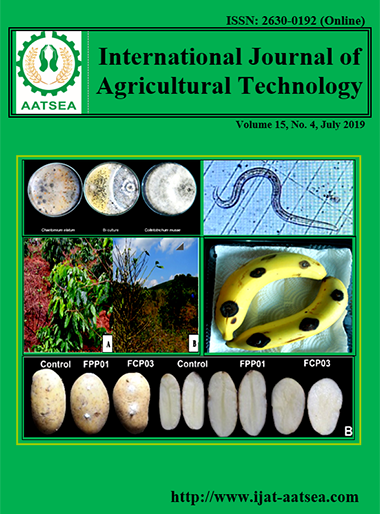Effects of honey and flower on the longevity and parasitization of Cotesia vestalis Haliday (Hymenoptera: Braconidae) on Plutella xylostella (L.) (Lepidoptera: Plutellidae)
Main Article Content
Abstract
Potential effects of honey and yellow cosmos (Cosmos sulphureus) on the longevity and parasitization of Cotesia vestalis were investigated. Results showed that when comparing diets from different honey-diluted solutions to water, 50% honey-diluted solution significantly increased longevity for both male and female parasitoid Cotesia vestalis. Mean longevities of male and female parasitoids were 10.16 ± 0.59 days and 10.8 ± 0.76 days, respectively. Similar results were obtained when using yellow cosmos flower (C. sulphureus), 50% honey-diluted solution, mixed honey and pollen, and honey-pollen to evaluate the longevity of C. vestailis parasitoids. Moreover, honey-pollen treatment significantly increased the parasitism efficiency of C. vestalis on the diamondback moth Plutella xylostella (L.) larvae, which gave the highest mean number of emergent parasitoids per day compared to the control. Results indicated that diets of honey and yellow cosmos (C. sulphureus) pollen extended longevity and benefitted the parasitization of C. vestalis.
Article Details

This work is licensed under a Creative Commons Attribution-NonCommercial-NoDerivatives 4.0 International License.
References
Cameron, P. J., Walker, G. P., Keller, M. A. and Clearwater, J. R. (1997). Host specificity assessments of Cotesia plutellae, a parasitoid of diamondback moth. In: Sivapragasam A, Loke WH, Hussan AK, Lim GS (eds) Proceedings: the management of diamondback moth and other crucifer pests. Malaysian Agricultural Research and Development Institute, Kuala Lumpur, pp. 85-89.
Godfray, H. C. J. (1994). Parasitoid behavioral and evolutionary. Princeton University Press Books, Princeton, pp.488.
Goulet, H. and Hubert, J. T. (1993). Hymenoptera of the world: an identification guide to families. Research Branch, Agriculture Canada Publication, pp. 395-448.
Heimpel, G. E. and Collier, T. R. (1996). The evolution of host feeding behaviour in insect parasitoids. Biological Reviews, 71:373-400.
Heimpel, G. E., Rosenheim, J. A. and Kattari, D. (1997). Adult feeding and lifetime reproductive success in the para-sitoid Aphytis melinus. Entomologia Experimentalis et Applicata, 83:305-315.
Jervis, M. A. and Kidd, N. A. C. (1986). Host-feeding strategies in hymenopteran parasitoids. Biological Reviews, 61:395-434.
Kawaguchi, M. and Tanaka, T. (1999). Biological characteristics of a larval endoparasitoid, Cotesia plutellae (Hymenoptera: Braconidae): host stage preference, subsequent sex ratio of progeny and mate location of males. Applied Entomology and Zoology, 34:213-221.
Mitsunaga, T., Mukawa, S., Shimoda, T. and Suzuki, Y. (2006). The influence of food supply on the parasitoid against Plutella xylostella L. (Lepidoptera: Yponomeutidae) on the longevity and fecundity of the pea leafminer, Chromatomyia horticola (Goureau) (Diptera: Agromyzidae). Applied Entomology and Zoology, 41:277-285.
Nhi, Yen, V. H., Lien, L. T. B., Chi, D. T. K., Dat,T. T., Thao, N. T. T., Thinh, T. D., Tinh, D. T., Bach, N. T., Toan,T. H., Nam, N. D. and Chau, N. N. B. (2014). Investigation natural enemies and insect pests in some VietGAP vegetable field in Hoc Mon area and study the parasitism capacity of Cotesia Plutella Kurdjumov. Journal of Science Ho Chi Minh City Open University, 37:19-29 (In Vietnamese with English abstract).
Noda, T., Miyai, S., Takashino, K. and Nakamura, A. (2000). Density suppression of Plutella xylostella (L.) (Lepidoptera: Yponomeutidae) by multiple releases of Diadegma semiclausum (Hymenoptera: Ichneumonidae) in cabbage fields in Iwate, northern Japan. Applied Entomology and Zoology, 35:557-563.
Onagbola, E. O., Fadamiro, H. Y. and Mbata, G. N. (2007). Longevity, fecundity, and progeny sex ratio of Pteromalus cerealellae in relation to diet, host provision, and mating. Biological Control, 40:222-229.
Rivero, A. and West, S. A. (2002). The physiological costs of being small in a parasitic wasp. Evolutionary Ecology Research, 4:407-420.
Roitberg, B. D., Boivin, G. and Vet, L. (2001). Fitness, parasitoids, and biological control: An opinion. The Canadian Entomologist, 133:429-438.
Russell, D. A. (1987). A simple method for improving estimates of percentage parasitism by insect parasitoid from field sampling of hosts. New Zealand Entomologist, 4:38-40.
Sugiharti, W., Trisyono, Y. A, Martono, E. and Witjaksono. (2018). The role of Turnera subulata and Cosmos sulphureus flowers in the life of Anagrus nilaparvatae (Hymenoptera: Mymaridae). Jurnal Perlindungan Tanaman Indonesia, 22:43-50.
Talekar, N. S and Yang, J. C (1993). Influence of crucifer cropping system on the parasitism of Plutella xylostella (Lepidoptera: Yponomeutidae) by Cotesia plutellae (Hymenoptera: Braconidae) and Diadegma semiclausum (Hymenoptera: Ichneumonidae). Entomophaga, 38:541-550.
Verkerk, R. H. J. and Wright, D. J. (1996). Effects of host plant-selective insecticide interactions on larvae of Plutella xylostella (Lepidoptera: Yponomeutidae) in the laboratory. Pesticide Science, 44:171-181.
Whitfield, J. B. (1997). Subfamily Microgastrinae. In: Wharton, RA., Marsh, P. M. and Sharkey, M. J. (Eds). Manual of the New World genera of the family Braconidae (Hymenoptera). Special Publication No. 1. International Society of Hymenopterist, Washington D.C., 333364.
Winkler, K., Wäckers, F. L., Kaufman, L. V., Larraz, V. and van Lenteren, J. C. (2009). Nectar exploitation by herbivores and their parasitoids is a function of flower species and relative humidity. Biological Control, 50:299-306.


